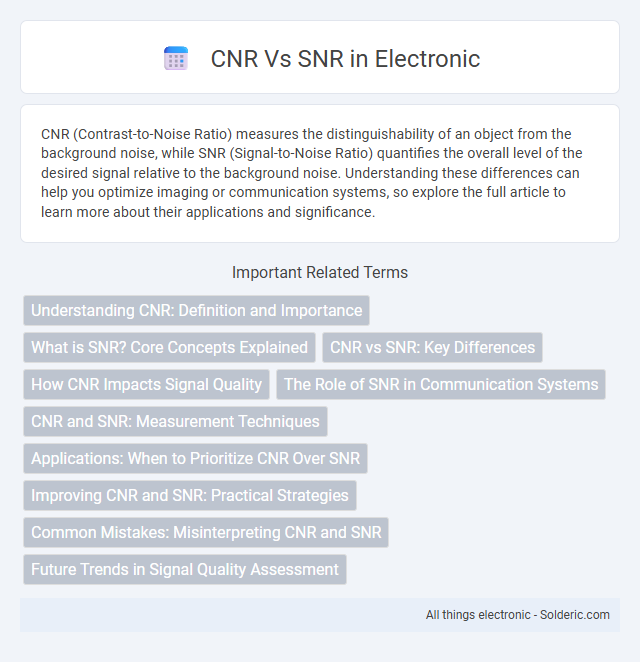CNR (Contrast-to-Noise Ratio) measures the distinguishability of an object from the background noise, while SNR (Signal-to-Noise Ratio) quantifies the overall level of the desired signal relative to the background noise. Understanding these differences can help you optimize imaging or communication systems, so explore the full article to learn more about their applications and significance.
Comparison Table
| Aspect | CNR (Carrier-to-Noise Ratio) | SNR (Signal-to-Noise Ratio) |
|---|---|---|
| Definition | Ratio of carrier signal power to noise power. | Ratio of total signal power to noise power. |
| Application | Used in modulated signals (e.g., radio, TV broadcasting). | Used in general signal processing across various fields. |
| Formula | CNR = Pcarrier / Pnoise | SNR = Psignal / Pnoise |
| Measurement Unit | Decibels (dB) | Decibels (dB) |
| Focus | Focuses specifically on carrier power level relative to noise. | Includes entire signal's power relative to noise. |
| Importance | Critical in assessing quality of radio frequency transmissions. | Essential for evaluating overall signal clarity and performance. |
Understanding CNR: Definition and Importance
Contrast-to-Noise Ratio (CNR) measures the difference in signal intensity between distinct features relative to background noise, playing a critical role in image clarity and diagnostic accuracy. Unlike Signal-to-Noise Ratio (SNR), which quantifies overall signal strength against noise, CNR specifically evaluates the contrast quality necessary for distinguishing fine details in medical imaging and remote sensing. Higher CNR values enable improved object detection and segmentation, making it essential for precise analysis in fields like MRI and satellite imagery.
What is SNR? Core Concepts Explained
Signal-to-Noise Ratio (SNR) quantifies the level of a desired signal relative to background noise, crucial for accurate data transmission and reception. A higher SNR indicates clearer, more distinguishable signals, enhancing communication quality and system performance. SNR is typically measured in decibels (dB), representing the ratio between signal power and noise power within a given bandwidth.
CNR vs SNR: Key Differences
CNR (Carrier-to-Noise Ratio) measures the strength of the carrier signal relative to background noise, while SNR (Signal-to-Noise Ratio) compares the overall signal power to noise power. CNR is primarily used in communication systems involving modulated signals, providing insight into the quality of the carrier signal itself, whereas SNR applies broadly to any signal where noise presence affects clarity. Understanding the distinction between CNR and SNR helps you optimize signal quality and improve system performance by targeting the specific type of noise affecting your transmission.
How CNR Impacts Signal Quality
CNR (Carrier-to-Noise Ratio) directly measures the strength of the desired carrier signal relative to background noise, impacting signal quality by determining the clarity and reliability of the communication. Higher CNR values indicate a cleaner and more distinguishable signal from noise, resulting in fewer errors and improved performance in wireless and satellite communications. Your system's overall signal quality depends heavily on maintaining a high CNR to ensure accurate data transmission and reception.
The Role of SNR in Communication Systems
Signal-to-Noise Ratio (SNR) plays a crucial role in communication systems by quantifying the clarity of the transmitted signal relative to background noise, directly impacting the quality and reliability of data transmission. High SNR values indicate clearer communication channels, enabling higher data rates and lower error probabilities, which are essential for efficient modulation and decoding processes. Optimizing SNR enhances system performance, reduces bit error rates (BER), and improves overall spectral efficiency in both wired and wireless communication networks.
CNR and SNR: Measurement Techniques
CNR (Contrast-to-Noise Ratio) and SNR (Signal-to-Noise Ratio) are measured using specialized instruments like oscilloscopes and spectrum analyzers that capture signal intensity and noise levels. SNR measurement involves quantifying the ratio of the desired signal power to the background noise power within a specified bandwidth, often using algorithms that filter out noise contributions. CNR assessment compares the contrast difference between two signal intensities relative to noise, predominantly in imaging systems, using techniques such as region-of-interest analysis and statistical noise estimation.
Applications: When to Prioritize CNR Over SNR
CNR (Carrier-to-Noise Ratio) is prioritized over SNR (Signal-to-Noise Ratio) in applications involving digital broadcasting, satellite communications, and cable TV systems where carrier detection and demodulation accuracy are critical. You should focus on CNR when measuring the quality of the carrier signal in RF transmission environments to ensure reliable data or video reception. SNR is more relevant for general audio or analog signals, but CNR provides a clearer metric for evaluating signal integrity in complex modulated systems.
Improving CNR and SNR: Practical Strategies
Improving CNR (Contrast-to-Noise Ratio) and SNR (Signal-to-Noise Ratio) involves optimizing imaging parameters such as increasing signal strength through higher field strength MRI or enhanced sensor sensitivity. Employing noise reduction techniques like advanced filtering algorithms and hardware improvements, including low-noise amplifiers, significantly enhances image clarity. Proper calibration and utilization of contrast agents can further boost CNR, enabling more precise differentiation between tissues.
Common Mistakes: Misinterpreting CNR and SNR
Misinterpreting CNR (Carrier-to-Noise Ratio) and SNR (Signal-to-Noise Ratio) often leads to inaccurate network performance assessments, as CNR specifically measures the ratio between the carrier signal and noise within a communication system, while SNR compares the total signal power to the noise power. Confusing these two metrics can result in improper troubleshooting and optimization, especially in RF and satellite communications where precise signal quality evaluation is critical. Accurate differentiation ensures better calibration of receivers and enhances the reliability of data transmission analyses.
Future Trends in Signal Quality Assessment
Future trends in signal quality assessment emphasize advanced metrics like CNR (Carrier-to-Noise Ratio) over traditional SNR (Signal-to-Noise Ratio) for more precise evaluation in complex communication environments. Machine learning algorithms are increasingly integrated to dynamically analyze CNR, enabling real-time optimization of your signal performance in wireless networks. Enhanced hardware sensitivity and adaptive filtering techniques further improve the accuracy and reliability of CNR measurements, shaping the next generation of telecommunications diagnostics.
CNR vs SNR Infographic

 solderic.com
solderic.com